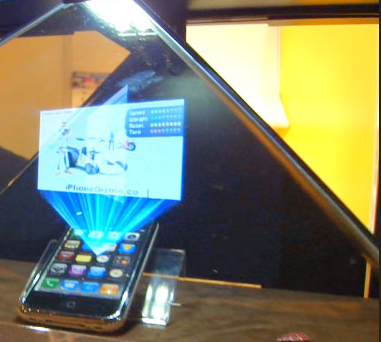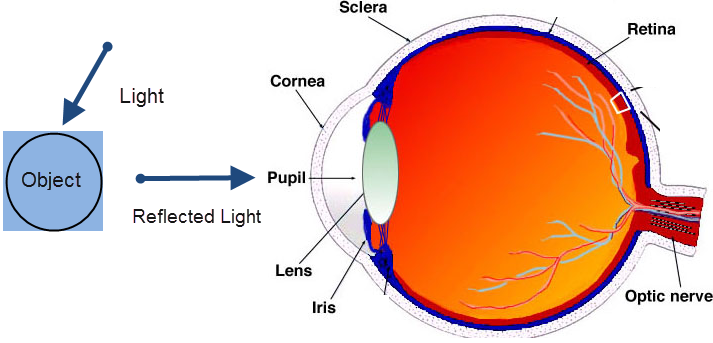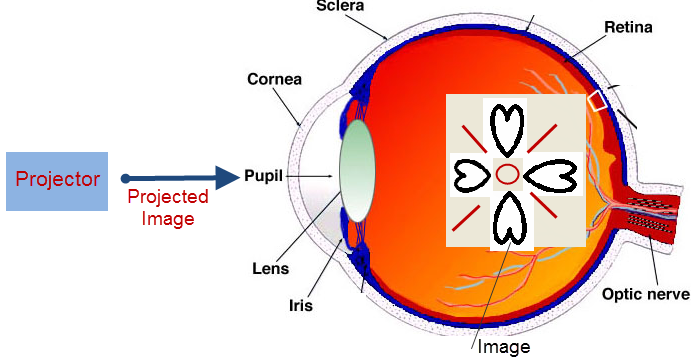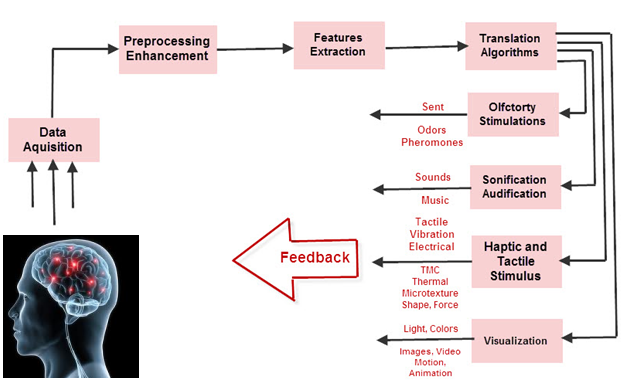Nowadays, advanced technologies are
growing faster wherein each technology is renewed with implementation of
new one. The current trending display technology most commonly used in
gadgets such as tablets, smart phones, etc., is the touch-screen
display, which will become outdated in the near future. Screenless
display is the advanced display technology, which replaces the touch screen technology
to resolve the problems and to make lives more comfortable. Therefore,
this article is intended to give an idea of the screenless display,
which transmits or displays the information without using a projector or
the screen. By using this screenless display technology, we can display
the images directly on the open space, human retina and also to the
human brain.

During the year 2013, this display came
into progress by the implementation of products like virtual reality
headsets, retinal displays and holographic videos. Lack of space is the
major drawback for most of the screen displays. This problem can be
overcome by the use of screenless displays.
What is Screenless Display?
Screenless display is an interactive
projection technology developed to solve the problems related to the
device miniaturization of the modern communication technologies.
The lack of space on screen based displays provides an opportunity for
the development of screenless displays. As the name indicates screenless
display has no screen and it can be defined as a display used to
transmit any data such as pictures or videos without the help of
screens.
Types of Screenless Display
Screenless display technology is divided into three main categories:
- Visual Image Display
- Retinal Display
- Synaptic Interface
The first category, visual image is
defined as the things that can be seen by the human eye such as
holograms. The second category, retinal display – the name
itself- indicates the display of image directly onto the retina. The
third category , synaptic reference which means sending information
directly to the human brain. Let us look on in detail about these three
display types.
1. Visual Image Display
The visual image is a type of screenless
display, which recognizes any type of image or thing with the help of
the human eye.The following are few examples of the visual image
display: holographic display, virtual reality goggles, heads up display,
etc. The working principle of this display states that the light gets
reflected by the intermediate object before reaching the retina or the
eye. The intermediate object can be a hologram, Liquid Crystal Displays (LCD)s or even windows.

By using the components like Helium Neon Laser, an object, a Lens,a holographic film and mirror, the Holographic Displays display
the three dimensional (3D) images. A 3D image will be projected and
appears to be floating in the air whenever the laser and object beams
overlaps with each other. This display can supply accurate depth cues
and high-quality images and videos that can be viewed by the human eyes
without any need of special observation devices. Based on the colors of
the laser projector, images are formed in three distinct planes.
Holographic displays are commonly used as an alternative to screens.

Heads up display are
also named as transparent displays. These displays are applied in
different applications such as aeroplanes, computer games and
automobiles, etc. Many of the users do not need to look away from their
field of view because the device displays the information on a
windshield. An orginary heads up display comprises of following
components: a projector unit, combiner and a computer. The projector
unit projects the image, and the combiner redirects the displayed image
by that projected image, and the field of view are seen simultaneously.
The screenless computer acts as an interface between the projector and
the combiner (data to be displayed).

The main advantage of visual image
displays is creating and manipulating the images upto any size. In this
category of displays, multiple bitmaps can be composited together in the
object mode and, in the image mode, manipulation takes place. In this display system,
Eye files are created which consists of all the images that are loaded.
The EYE file creates a ‘Export Project Command’ in the file. These
commands in EYE file provide a provision to save any sort of unsaved
images in the form of bitmaps into it. A common catalog is created to
place the browsed images from ‘Export Editor Command’ in the ‘EYE’ file.
2. Retinal Display
The second category of advancement in display system,
retinal display as the name itself indicates the display of image
directly onto the retina. Instead of using some intermediate object for
light reflection to project the images, this display directly projects
the image onto the retina.The user will sense that the display is
moving freely in the space. Retinal display is commonly known as retinal
scan display and retinal projector.This display allows short light
emission, coherent light and narrow band color. Let us know about this
display with the help of the following block diagram.

The block diagram of the virtual retinal
display consists of following blocks: photon generation, intensity
modulation, beam scanning, optical projection and drive electronics.
Photon generation block generates the coherent beam of light; this
photon source make use of the laser diodes as coherent source with
retina display to give a diffraction onto the retina of the human eye.
The light generated from photon source is intensity modulated. The
intensity of the light beam gets modulated to match the intensity of the
image.

The modulated beam gets scanned by the
beam scanning. By using this scanning block, the image is placed onto
the retina.In this beam scanner, two types of scanning modes takes
place: raster mode and vector mode. After the scanning process, optical
projection takes place for projecting a spot-like beam onto the retina
of the eye. The spot focused on the eye is sketched as an image.A drive
electronics placed on the photon generator and intensity modulator is
used for synchronization of the scanner, modulator and coming video
signal. These displays are made available in the market by using MEMS technology.

3. Synaptic Interface:
The third category, synaptic interface
means sending information directly to the human brain without using any
light. This technology is already tested on humans and most of the
companies started using this technology for effective communication,
education, business and security system.
This technology was successfully developed by sampling the video
signals from horse crab eyes through their nerves, and the other video
signals are sampled from the electronic cameras into the brains of
creatures.

The brain computer interface allows
direct interaction between the human brain and external devices such as
computer.This category can also be known by different names such as human machine interface, synthetic telepathy interface, mind machine interface and direct neural interface.
These are the three types of latest Screenless displays
which replace the current use of touch screen technology to fill the
lack of space in the screen-based electronic displays.We hope that the
future definitely looks promising for this technology. Let us wait for
the day when we all will be treated by this technology. Leave your
comments below.






No comments:
Post a Comment